Influence of Technology on Artists and Art
Info: 9330 words (37 pages) Dissertation
Published: 24th Nov 2021
Tagged: ArtsTechnology
How technology has, and continues to, extend the possibility for contemporary artists and for their artwork, currently and into the future
The following thesis aims to examine how technology has changed and influenced artists and their artwork, in the past, present and future. “The further technology progresses and the more art evolves and changes; the easier it becomes to see how closely linked the two are… we represent, understand, and experience the world around us through art while we constantly alter and rearrange that world we experience through technology” (Connor, 2014). Gamboa (2017) goes further and said that the word ‘art’ has undergone a rebirth. The word art no longer summons only thoughts of classical paintings, it also evokes images of digital art. This reflects how embedded technology has become in the art world. Coeckelbergh (2016) even suggest that machines can create art, an idea that not long ago would have seemed absurd if not utterly insane.
Art and science or technology is not a new phenomenon. Reichle examined this relationship closely in “art in the age of technoscience”. Reichle states that over the past thirty years there has been an increased collaboration between science, technology and art. This is contributed to the fact that technology has become embedded in all aspects of our everyday life. Williams (2017) states there is a growing need for integration between artist and technoscience. Scientists rely on artist to transform their studies and experiments into a visual media that the public can understand. Williams reports that the cultural divide between art and science is “relatively new”, and that until the Victorian era the two fields worked cohesively. The split between art and science occurred in the Victorian era, which led to what physicist Snow called “the two cultures”. The relationship between art and science reached its peak during the Renaissance. Leonardo da Vinci being the prime example of this. With the relationship between art and technology being re-established what changes have we seen in artists and their artwork? How much has technology really influenced the art world? This will be discussed further in chapter two.
The integration of technology in art does bring about much discussion, and the negative aspects must also be acknowledged. Falconer (2016) wrote an article on the Tate website, she said that fine art purists have shown a “wary scepticism” towards new technology, while the “tech-heads” have demonstrated resistance to art’s influence. Zaher (?year) states that artists face such a myriad of options that they can become “overwhelmed, confused and puzzled” which is reflected in their artwork. Zaher also mentions the fear expressed by the idea of loss of the human element/hand in art. These negative aspects will be discussed in further detail in chapter three.
The thesis consists of five chapters that will discuss the above ideas in further detail. Chapter one will review the literature available. Chapter two examines the artist influenced by technology. Chapter three discussed positive and negative aspects of art. Chapter four looks to the future of art and technology.
Chapter one
The following literature review will be based primarily on three books and two articles. The shock of the new, Art and the Century of Change, updated and enlarged edition, by Hughes (2005) is a detailed examination of how art has been influenced by social events and the release of technology in the past century. It examines how artists and artwork have reflected these changes, from the introduction of cubism as a reaction to machinery in everyday life, to Dadaists who believed they could “save mankind from political abominations” following world war 1. The extended version of The shock of The New has a final chapter where Robert Hughes returns to examine the art movements from 1970 to 2005. The second book used is Reichle (2009) “Art in the Age of Technoscience, Genetic Engineering, Robotics, and Artificial Life in Contemporary Art”. This book follows artists who incorporate science and technology in their artwork. The focus is on how artists adopt and incorporate technology usually reserved to scientists and experiments. The final book L. candy and E. Edmonds (2002) Explorations in Art and Technology takes a look at the creative process through the eyes of the participating artist whilst using new technology. The first article is Digital Divide (2012) by Clare Bishop- this article is seen as the catalyst for examining contemporary and new media art. The article caused much discussion and debate after it was published, and is still referred to in recently published writings. The final article is an E-journal by H. Pritchard and Prophet (2015) titled Diffractive Art Practices: Computation and Messy Entanglements between Mainstream Contemporary Art, and New Media Art. This article calls to question the divide between mainstream contemporary and new art media. The aim of this literature review is to examine the introduction of technology into art, and how we as artists have reacted to this change.
Hughes (2005, P.15) comments on the speed in which culture had reinvented itself in the nineteenth century. The speed of change then could almost be seen as glacial in relation to now. In 1982 computers were available for home use, in 1989 the World Wide Web was invented,1994 seen JPEG introduced, allowing images to be seen, 1989 Google came along, 2007 seen the release of the first Iphone, and 2010 the I Pad. The speed of new technology being release has only increased. We are currently on the 18th I Phone! While Hughes spoke of a different era (the transition from steam to electricity) the feelings and thoughts are still relevant today “the sense of an accelerated rate of change in all areas of human discourse, including art” (2005, P.15).
Kidner (Candy and Edmonds 2002, P.197-204) reflects on his personal experience when faced with new technology being released. Kidner started life “as a painter” in the1950’s with no experience with computers. Over his life Kidner has embraced, if not always willingly, new technology. Upon reflection “I have come to realize the inescapable value that the computer has to offer”. The newfound respect for the computer wasn’t instantaneous, Kidner thought it a “seductive toy”, he was suspicious and he “begrudged the time but more that I was afraid of losing sight of the purpose while acquiring the necessary skills”. Unlike Kidner, David Hockney has fully embraced new technology. Hockney (BBC: David Hockney The Art of Seeing, time. 34Min12Sec) discusses the benefits of technology, focusing on his use of the I Pad. He describes how he can establish colour and masses much quicker than any other medium.
Not all people see eye to eye when technology is introduced to art. Pritchard and Prophet (2015, P.5-11) scrutinize how the development of technology has only caused a greater divide in the art world. They highlight how both artists and the institutions are “surprisingly fixed” when self identifying as ‘new contemporary art’ or ‘new media art’. The outline of what is or isn’t included in each group is so rigid that artists seeking to merge the two in their artwork have been “excluded from both”. Bishop (2012) also touches on this topic; she acknowledges that “an entire spear” of new media art does focus on social aspects and technology advances. She also notes the divide in the art world “[new media art] rarely overlaps with mainstream art world”.
Pritchard and Prophet (2015, P.7) also note the changes in art, they suggest that mainstream contemporary art and new media art “are always in the process of being reconfigured, changing what they are and what they can be”. However Bishop (2012) takes a very outspoken opposing view. Bishop does acknowledge that artists are embracing technology, but using it only to produce artworks. She also begs the question “but why is contemporary art so reluctant to describe our experience of digitized life?” R. Hughes The shock of the New (episode eight, 1980) suggests that the basic point of art is to interpret the world and make it “comprehensible” with each individual artist “mediating in some way between a sense of history and an experience of the world.” So where have we failed? Both Bishop and Hughes have outlined the success in regards to accepting technology, but only in the production of art. Artists have failed in general, according to Bishop (2012, P.1) to “really confront the question of what it means to think, see, and filter affect through the digital”. Bishop wrote that the split between contemporary and new media art occurred with the introduction of DVD in 1997. New media art embraced technology while contemporary artists became fixed on the nostalgic aspect of older, obsolete methods. Contemporary art could be described as ‘stuck’ following this divide. But this is changing, as new media art is slowly making an entrance into the mainstream galleries. Indeed the Tate has introduced the IK prize in 2014. This prize is awarded to artists or an “idea that uses digital technology to innovate the way we discover, explore and enjoy British art”.
The above literature review is a reflection on the integration of art in past years. The literature shows a divide in opinions; some embrace these changes, whilst others remain wary. Farago (2014) highlights the need to constant change and reinvention;
“All living things are subject to change. Change is, oxymoronically, the great constant of the universe, and every living organism must respond to change if it is to survive”. Gever (2012) a 3D digital sculptor writes that technology and art are interlinked now more than ever. This merging results in “entirely new art forms” with art becoming less “static”.
Chapter Two
IMMA released an article which describes movements in art which are a direct result of technological advancements. Oil paint resulted in transformation of painting style during the Renaissance. Later the camera obscura resulted in artists creating artworks with more lifelike perspective. The rise of the industrial revolution resulted in the Cubist movement. The introduction of the camera caused photography to become a focal medium for many artists. Performance art was born of the artist’s desire to experiment with new technology to produce encompassing works. This article reflects many of the ideas portrayed in ‘The Shock of the New’ by Robert Hughes. I will have a closer look at artists who embraced change and new technology during their lifetime.
Robert Rauschenberg
Robert Rauschenberg is the apotheosis of artists embracing technology and change. Robert Rosenblum (Hughes 2005, p334) remarked that “every artist after 1960 who challenged the restrictions of painting and sculpture and believed that all of live was open to art is indebted to Rauschenberg”. Tate describes him as an artist who anticipated the pop art movement. While Rauschenberg was primarily a painter and sculptor, he explored many different fields including photography, printmaking, papermaking, and performance.
This experimentation and broadening of techniques was not always embraced by critics, indeed in the 1960’s formalist critics loathed how his work which embodied modernism. Rauschenberg’s’ work was described as “jumpy, eclectic, self-indulgent, impure and not serious” (Hughes 2005, p. 333)
Rauschenberg also developed an interest in art activism: his “Experiments in Art and Technology” (EAT) initiative encouraged collaborations between artists and scientists. Indeed Rauschenberg was invited to the NASA launch of Apollo 11, the first manned space flight. He created a series of lithographs titled Stoned Moon. This involved combining diagrams and other images from NASA’s archives with photographs from various media outlets, as well as with his own work. Rauschenberg being an artist and influenced by technology sought help creating his works, he looked to Gemini G.E.L and other technology advanced printmakers. The resulting artworks were considered outstanding landmarks in innovation (Carey 2011, P.221). Rauschenberg broke the boundaries of art, often with the aid of technology. Again with the aid of Gemini G.E.L Rauschenberg created Autobiography the first fine art print with a billboard size press. Using a negative image x-ray of himself, Rauschenberg sought advice from known astrologers, and incorporated an astrology chart based on his date of birth. Astrology was seen as a new emerging science at this time. Rauschenberg used the tools and technology available to him to create images that were physically and imaginatively idiosyncratic.

Retroactive I, 1963
Oil and silkscreen ink on canvas
213.4 × 152.4 cm
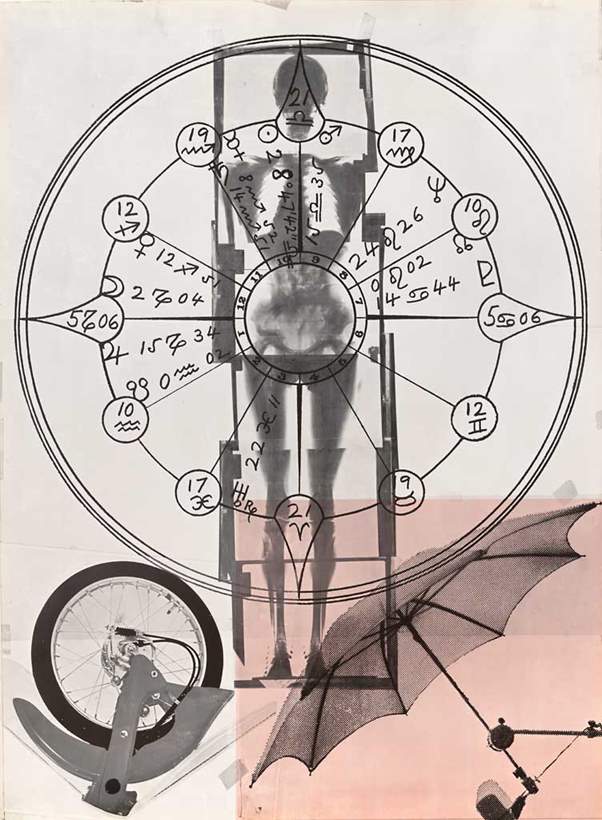
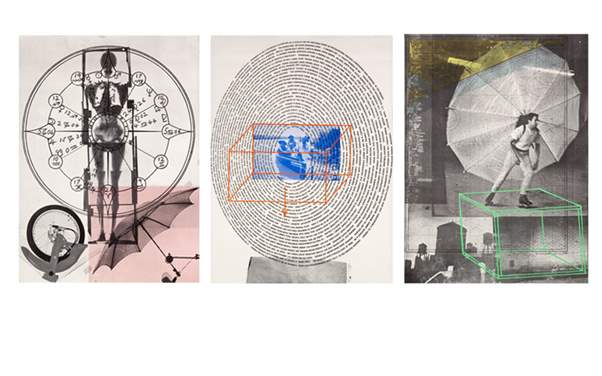
Autobiography, 1968
Three panel offset lithograph on three sheets
168.3 × 123.8 cm
David Hockney
David Hockney is another case in point of artists embracing technology. Indeed, Hockney incorporates technology as a part of his practice. His focus appears to be perception, he uses a variety of mediums to probe and explore perception throughout his career (met museum 2017). The Tate museum wrote that Hockney “continues to change his style and ways of working, embracing new technologies as he goes” Hockney is considered one of the most influential artists of the twentieth century and an important contributor to the pop art movement of the 1960s (The Tate 2017). Hockney is a very multifaceted artist, using almost every medium available to him, including “full-scale opera set designs, prints, and drawings using cutting-edge technology such as fax machines, laser photocopiers, computers, and even IPhones and IPads” (artsy 2017). Weschler (2013) commented on Hockney’s versatility, that his persistent youthfulness contributes to his interest in new gadgets and technology. Weschler (2013) remarks that Hockney often sees the artistic value of technological advances before others. This willingness to adapt and change has seen Hockney produce works that push the boundaries of art, and ensures he remains a prevalent figure in the contemporary art world.
One cannot mention Hockney without making comment on the Hockney-Falco theory; this stipulates that artists during the renaissance era used ‘technology’ available to them to aid creating their masterpieces. Hockney posited that the Old Master painters used camera obscura techniques to project images of their subjects onto their paintings’ surfaces, leading to the photographic quality of Renaissance painting. (artspace, 2017)The artists used optical projected images to aid creating perspective in their drawings, creating a realistic appearance in their portraits. While this theory has caused much controversy, if proven correct, it shows that artists of even that era used technology to aid their works.
Hockney’s technical curiosity and obsession with naturalism lead to many experiments with new technologies throughout this career. Hockney experimented with photocopiers and fax machines as tools for making pictures. In 1968 Hockney began his experimentation with technology, using Xerox and collage (and an office photocopier) to create self portraits (Niland, 2012). 1986 saw another technology become evident in Hockney’s work, the Polaroid picture. Pearblossom highway is a photographic collage. Hockney worked with photographs before, but found the images to be flat and lacking perspective. He commented that photography was alright “if you don’t mind looking at the world from the point of view of a paralysed Cyclops, for a split second.” (Wheschlar 2012) He adopted the collage and merged the two with the aim of creating realistic perspective, to truly reflect the world we live in.
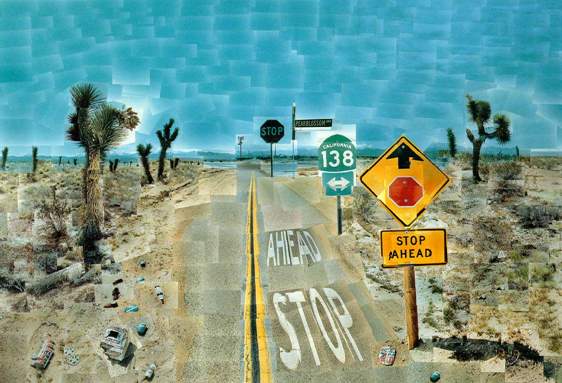
Pearblossom Hwy., 11 – 18th April 1986, #2
Chromogenic print
181.6 × 271.8 cm
In 1989, with the emergence of the fax machine, Hockney was enthralled with a new technology. Hockney sent faxes to friends and colleges. Interestingly, in later years this led to much debate. Where the faxes as important as the originals? In October 1999 (ten years after the images were faxed) the images were being sold for substantial amounts of money. Hockney faxed the auctioneers “The whole point of the faxes I made in 1989 is that they were given away. They cannot be sold, how would I be paid?” His brother Paul said “David reckons they are just worthless – they are just copies of an original.”(The Guardian 1999) This is a debate that will be discussed later in chapter three. Most recently, however, he has produced hundreds of paintings using applications on an IPhone and IPad. In an interview with The Guardian Hockney said that ‘the IPad is like an endless piece of paper that perfectly fitted the feeling I had that painting should be big.’ It will be interesting to see if these pieces created by Hockney lead to further discussion about ownership. It is well known that Hockney sends IPad images to friends and colleagues. Is Hockney in possession of the image, or is the receiver also in possession? The file exists in both areas simultaneously, both images show the final presentation piece of artwork, does it matter that Hockney has the software that shows the detailed execution of the artwork. The counter argument is that one can only buy and own a final artwork-you do not buy the brushes used to create the image. This will be an interesting area to watch in the coming years.
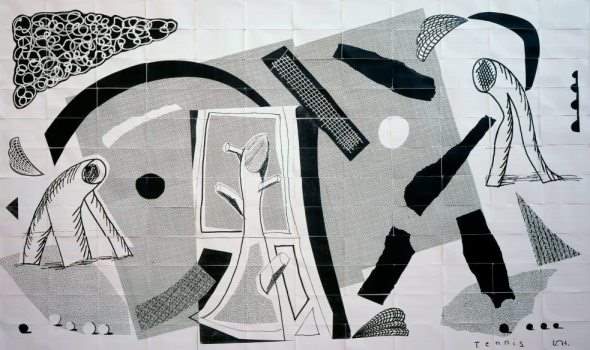
Tennis 1989. (Fax art)
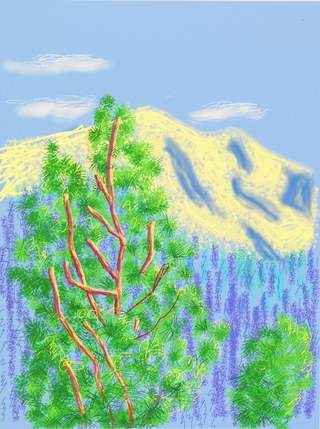
“Untitled No.9” from “The Yosemite Suite”, 2010
IPad drawing printed on paper
94 × 71.1 cm
Marc Quinn
Marc Quinn was one of the major figures of the 1990s in the British contemporary art scene, known as one of the Young British Artists. Quinn explores ‘what it is to be human in the world today’ through subjects including the body, genetics, identity, environment and the media. The National Portrait Gallery in London commissioned a portrait of Nobel Prize winner Sir John E. Sulston for his contribution to genetics. Quinn obtained a sample of DNA for Sulston and created a portrait from it. The sample of DNA was replicated using cloning techniques in bacterial cultures. The bacteria colonies that contain the DNA where placed on a glass plate of agar jelly. The resulting portrait was deemed entirely “true-to-life” as it depicted Sulston’s’ genetic code. While not a typical portrait, this DNA portrait was very appropriate considering Sulston’s area of study. Sulston stated that the portrait “contains all my genes… it’s my starting point”. Martin Kemp, a British art historian reflects on the artwork and comments that although it is not a functional portrait, this portrait is really a piece of the actual person rather than just an image captured in time. Although others disagree with the concept, one critic (editor for Oxford Journal of Medicine) wrote “It’s as if the artist has failed to appreciate the difference between information and data”.
Quinn exploded into the art scene with his sculpture Self (1991), a sculpture of his own head. The unique take on this sculpture was that it consisted of ten pints of the artists own blood. Quinn recreates this sculpture every five years or so. The blood was obtained over a five month period. No aspect of this sculpture could be created without the influence of technology. This is a sculpture of the artist, created entirely out of the artist himself. Quinn uses this as a metaphor to examine one’s own finiteness through “scientific knowledge and artistic expression”.
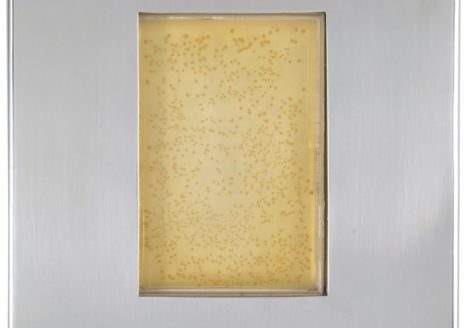
DNA Portrait of Sir John E. Sulston, 2001
Mixed media (Stainless steel, polycarbonate agar jelly, bacteria colonies, human DNA)
12.7 × 8.5cm
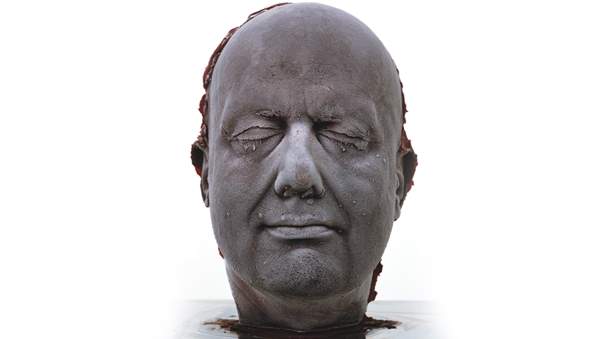
Self Portrait, 1991
Blood (artists’ own) and refrigeration equipment
JODI
JODI are pioneering net artists. JODI is a collaboration of two artists Joan Heemskerk and Dirk Paesmans (the first two letters of both artists’ names making the name JODI). Both artists began in video art and photography, transitioning to digital art in the 1990’s. JODI aim to mock the ever increasing presence of technology in every facet of our lives, and have caused much debate in the art world. JODI disassembles and disrupts popular video games, and indeed internet platforms like Google maps. They apply coding malfunctions to images of web pages we know and love, and introduce programming glitches to the amusement and often confusion of the public. JODI causes these disruptions to undermine our expectations of the platform or video games “it’s often the viewer who is struggling against the instabilities of technology” (Chayka 2015). JODI delight in showing us we take our technology far too seriously, once sticking a keyboard to a skateboard. GEO GOO (2008) comprised of a video of Google maps slowly crashing. The symbolic use of Google maps was provoking. The viewer can interact with settings, causing further glitches to occur. Watching Google maps, the most familiar view of the world, become gibberish on your screen is strangely disconcerting. Chayka (2012) experience a similar feeling of unease “there’s a strange sense of vertigo to seeing the digital version of our reality drive itself insane”.
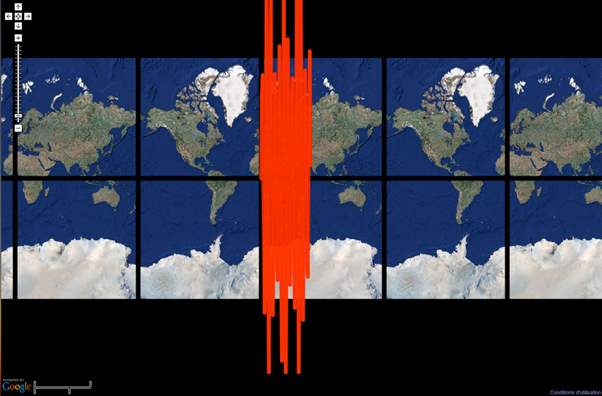
GEO GOO, 2008
Screen shot
JODI most famous artwork is their website JODI.org. The web page is coded in basic HTML format. Confronted with this page of seemingly nonsense code, the viewer can click anywhere on the page, which leads to further pages of code. Pieces of almost recognisable games pop up for no apparent reason. One can become lost or even reach dead ends without once reaching anything that resembles modern day websites. It is a rabbit hole of links and backtracking, only to find you’re completely lost and have no idea what it is you are even looking for.
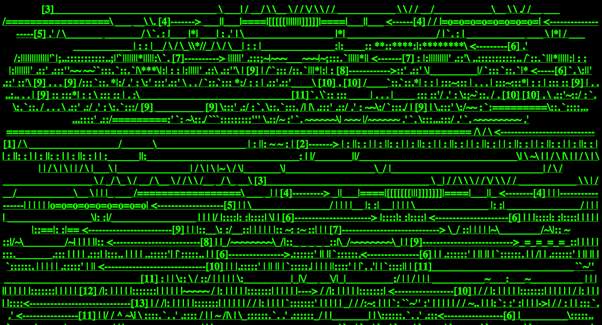
JODI.org
Screen shot
JODI again opens the argument of how to sell or own this artwork. Their artwork is easily accessible to millions online. How does one value such artwork? Can such artwork be sold in a traditional manner? I will discuss this further in chapter three.
Not all digital art has been embraced by critics. In 2014 Saatchi Gallery announced a new award for GIF art, titled Motion Picture Prize. GIF stands for Graphics Interchange Format. It is only in recent years that GIF art has been accepted as a form of digital art by galleries. According to Saatchi (2017) this form of art was only recently introduced because “Motion photography has emerged as a new trend, but until recently required special tools and know-how”.
Chapter Three
The above artists are a selection of artists who incorporate technology into their practice. The artists have used technology in very different ways, and with a variety of results. JODI are obviously influenced by technology, this is obvious in their collection. Their artwork is only possible with the use of technology. JODI creates artworks whose content cause the viewer to contemplate the use of, increasing, everyday technology. They examine the relationship between man and technology. While David Hockney incorporates aspects of technology, it is not the focus of his artworks. Hockney’s artwork is focused primarily on creating realistic visual perception. The imagery and landscapes are energetic and vibrant. There is an atmosphere of joy, of fun, almost childlike glee. Hockney transitions from one medium to another, between traditional methods and technology. Hockney manages to utilize all tools available to create artworks, without compromising on skill and technique. Marc Quinn uses technology to create sculptures aimed to explore the finity of life. Quinn uses technology to create a reflection of humanity. It blurs the line between art and science. Robert Rauschenberg’s artwork mirrors the fascination with technology during his lifetime. Humankind became engrossed with the advancements in science, particularly with space exploration. Rauschenberg worked alongside scientists while documenting this period. Rauschenberg saw the value of this collaboration. His artwork is a reflection of his interests in life. His artwork of portray a variety of thoughts and ideas coexisting. Combinations of objects and images from everyday life. The images created often reflect the influence of technology on humankind. We can see there are many ways to incorporate technology into art practice, many artists do. This use of technology provided the art world with a huge variety of artworks, and a wealth of inspiration was provided to artists by this technology. I believe that the above artists prove Clare Bishop incorrect. Artists have always, and will continue to, reflect the impact of technology on humanity. Artists not only literally reflect technology’s’ impact on humanity, they create artwork using technology.
The aforementioned artists highlight some of the positive aspects of technology. Technology can aid in all aspects of the art process. Inspiration can be gained by the use of the internet. Images can be created, edited and altered through various software tools available. Indeed the final artworks can even be sold online. But there are many questions to be answered, many problems left unsolved yet. How do you preserve it? How do you own it? Fear that art may become uninspired. There is a fear of the lack of ‘human hand’ in art.
Preservation of art is not a new issue, indeed museums have been preserving artwork for generations. The introduction of digital art has created a whole phletra of conservation problems. Le Maîtr and Barbara (2013) wrote of such issues. They highlight the issues of preservation in art. Such art is often created with new software, show in galleries with the use of technology, it can even be viewed on web pages. The artwork relies on functioning technology to be viewed. The issue occurs when the required technology becoming obsolete or non-functional. Le Maîtr and Barbara. (2013) coin the term “time-art” to reflect the finite time it can exist before the technology becomes obsolete. The use of technology to create artworks is seen as fundamental and integral to the finished piece, this causes even further issues. Le Maîtr and Barbara. (2013) say that previously museums simply repaired the malfunctioning equipment, “and the reproduction on specific hardware was rarely documented, the instruments that are condemned to obsolescence are nowadays frequently considered an integral part of the artwork, thus undermining the notion of their interchangeability”. One idea that is being pursued is digitally recording the artworks and storing them collectively. Jones and Beagrie (2002) were two authors who greatly contributed to Digital Preservation Coalition Handbook. It examines the many aspects and issues regarding preservation of digital works. There are six key points to consider before digitally preserving artwork;
- Keeping the data
- Keeping the meaning of the data
- Maintaining trust in the data
- Keeping the context of the data and its dependencies
- Acting in a timely manner
- Coping with the data deluge
Keeping the data: The initial storage of the file is the easiest step. Once stored the data can become corrupt-over time this occurs, there can be malicious damage of data, the data can become unreadable to new computers if the format is not updated periodically. The file can simply be lost if incorrectly stored, or indeed simply forgotten about over time. These are only a few examples of the difficulties faced when storing data. While there are companies who can store this information, this involves trusting third parties fully with your data. Any errors can be irreversible, rendering the artwork lost completely.
Keeping the meaning of the data: As said above, the data format occasionally must be updated. This occurs as software becomes obsolete. This begs the question, if the original file is altered, is the artwork altered. This was not a large a problem as first perceived by authors Jones and Beagrie. The majority of files are saved in popular format, as a result these formats should not become an issue over time.
Maintaining trust in the data: With the exception of essential maintenance, the file must remain unaltered from the original. The viewer must have confidence that when seeing an original image there has been no unnecessary alterations made. This maintaining of trust, in essence, depends solely of the integrity of parties who store the data.
Keeping the context of the data and it’s dependencies: This is a seemingly simple matter, but in truth is far more complex than initially thought. While an artwork today is obvious in its relevance to society and societal issues, in a hundred years this may not be easily understood. An image without context is simply an image. It seems a simple matter to create some background information, this is not the case. A stand alone file might give some background, but this is difficult to create without inevitable needing links to other surrounding information. One file soon requires another, leading on to another information file and so on. Like when one views a YouTube video to see how an artist paints, and suddenly hours later you appear to be watching funny cat clips. Neither are immediately related, but clicking similar video links can lead the viewer astray. Understanding the file contents and its relevance does help to some extent. It can limit the amount of information needed to create appropriate understanding.
Acting in a timely manner: The involvement of the creator/artist at an early stage may negate many of the above issues. Simple steps like saving the final artwork in a popular format saves the need to update the format later. Also involving the artist at an early stage may make keeping the context of the data much easier. For technology that is already obsolete Jones and Beagrie suggest consulting the relevant technology experts, and even suggest a case by case review.
Coping with the data deluge: The creation of data is expanding by approximately 60% a year. While storage data is only expanding by 25%. If storage data does not expand rapidly enough the desire to preserve data may not be an issue. There simply will be nowhere to store that data. This issue is being examined currently, with data storage companies continuously aiming to create smaller file sizes.
The above discuss artists using technology, and some of the obstacles they face in a technological advanced world. While many artworks could not be produced without the use of technology, has it influenced the actual artistic process? Hughes (the shock of the new, 2005) remarked “the basic project of art is always to make the world whole and comprehensible, to restore it to us in all its glory and its occasional nastiness, not through argument but through feeling, and then to close the gap between you and everything that is not you, and in this way pass from feeling to meaning… It’s done by individuals, each person mediating in some way between a sense of history and an experience of the world.” To answer this question we must first examine the artistic process. Defining the art process is a difficult task; each artist will have their own methods and variances. No two artist work in exactly the same manner .Botella et al. (2013) examined the creative process in their research “How artists create: Creative process and multivariate factors”. This involved interviewing twenty seven professional artists, and analysed the data in a qualitative and quantitative approach. The results indicate six individual and distinct stages in the creative process.
- The creative process began with an idea or a “vision”
- A second phase was documentation and reflection.
- The third moment was represented by the first sketches, first attempts at giving the project a material form.
- After sketches, there was normally a more or less extended period of testing the forms and ideas that originated from reflection and preliminary work.
- These tests, of making and remaking, ended up in provisional objects, “drafts” and almost-finished products.
- It was also often the case for a first object to be followed by a series.
While the sample size of the research was quite small in scale, I feel that it accurately portrays the creative process. Indeed I can relate to the above stages. Botella et al. address the small sample size, and report that the result of their research is in line with preceding studies. Also, of note, Botella et al. consider aspects not previously examined- the artist’s feelings, emotions, and influences. I shall use the results from the above study to examine how technology can possible influence the creative process, in either positive or negative aspects. According to Candy and Edmonds (2002) artistic practice is “closely influenced by the tools of the trade used by the artist”, and that “many questions and difficulties are associated” with computers in particular.
Step One - the idea or vision
Every creative process must begin with an idea. This idea can be a vague, underdeveloped thought or feeling the artist is intrigued by. However, an idea can also be the complete opposite, a moment of inspiration. A moment of utter clarity, whereby the artist is inspired with a complete concept, and work to create their vision. It is clear that not all artists work in the same manner. Marc and Ward (2002) determine there are three influences that can lead to this initial idea or vision; “the artist’s ongoing art-making enterprise, the interplay of life experience, and external influences”. During this stage technology can have a fundamental influence. Technology has become so ingrained in everyday life that “external influences” is inseparable from technology influences. Artists may become inspired by looking at artworks created by other artists, viewing images captured by another on social platforms etc. Artists no longer need to leave their studio to gain inspiration. Galleries can be viewed from the comfort of the artists’ home, although it must be said that seeing painting in person cannot be compared to an online image. The artist doesn’t need to travel the world to see images of a rainforest/ cityscapes, they simply need to have internet connection. The artist is not even confined to their studio; they can view images on their phone or tablet, anytime, anyplace, at their convenience.
While looking for inspiration has become easier, technology can have its drawbacks. The artist may feel overwhelmed simply due to the sheer volume of pictures available. The artist may find it harder to single out an original idea. Another drawback of technology is the amount of time one can waste away by browsing online, a concept that many are surely familiar with.
Step Two - documentation and reflection
Botella et al. describe this stage as “gather more information about the materials and technologies required”. Technology has made the process of gathering information much quicker, and simpler. A few clicks online can produce what would have taken hours or weeks prior to the internet. During this step the artist examines and develops a better understanding of which materials are most appropriate. Due to technology the media available has greatly expanded. This variety of media available has both positive and negative aspects. The greater variety can aid the artist in developing artworks that were previously impossible to create. The use of 3D printing etc can add elements that previously could not be created with the human hand. This does present some problems, the artist must be familiar with the technology in order to use it. The artist must take time to become competent in these new skills. The rate of new medias which artists can use can seem daunting to artists, and not all media have been fully accepted by the art world (such as GIF art). Technology can influence what types of material the artist will use, their own personal experience can limit or enhance the final artwork. Artists using new technology may encounter difficulties in the following creation process steps. While technology competent artists may increase the speed of production of artwork with technology’s aid. Quantrill (Candy and Edmonds, 2002) reflects on his use of technology to aid his creative process, “the idea is to use the…computer to enable forms of expression that are unique, where the human is the focus, but the expression is a composite of both human and machine”.
Step Three - first sketches
This step can occur in conjunction with step two, depending on the artists’ personal preference. During this stage the artist will begin to sketch their idea, often using a variety of mediums, tools, styles. The artist creates and refines the initial idea. Technology can aid in this process. The artist may use tools like photoshop to alter their image, without wasting materials and time on this initial stage. Technology can alter and refine the initial sketches until the artist is satisfied. By using tools like photoshop the artist can alter colours, angles, the arrangement etc until their vision is complete. The artist can use digital camera to document the various stages for review at a later time. The use of technology during this step is endless, and can greatly speed up the process for the artist, without the costs incurred by use of traditional methods. Quantrill (Candy and Edmonds, 2002) discusses his use of and experimentation with technology in art. He believes that technology can offer a new ways to “translate and transform” the art process. By integrating technology into his artistic process Quantrill can take the “new media and machines from a purely functional content into a context where their architecture itself is an additional contribution to creative works”.
Step Four and Five - drafts and the almost finished artwork
The artist should have a fixed idea for their final artwork. The artist will continuously make alterations to the artwork, however these changes are smaller details. Mace and Ward (2002) say that “the artwork now takes on physical constraints that may or may not have been previously considered or foreseen”. The artist reacts to these changes instinctually. However, the artist may encounter larger issue. Ceramics may crack; paints may not react as expected etc. The artist may have to rethink their approach if this is the case. Indeed artist may seek out help online through video tutorials if not familiar with a certain process or material. Botella et al. (2013) report the artist as being “tactile”, open to the “physical, sensorial, sensible properties of space” and required the dialog, the “confrontation” with the art object”. The artist is confronted with a variety of emotions- from joy at creating to despair when errors occur. The artist may seek information online, through discussion with peers, research on current artworks being produced by other etc. Mace and Ward (2002) report a frequent issue of “determining whether the work is indeed finished. This may be due to a difficulty being objectively evaluative while still emotionally engaged with the work”.
Step Six - A series
The artist will often create a series from their original idea. The artist makes alterations from the original. The artwork is released from the studio, into the public eye. This stage is where the artist seeks “recognition from others” according to Botella et al. (2013). The public and critics react to the artwork. Through with the use of technology the public have more of a voice over the years. Anybody can now comment on images through social media platforms. The artist can view these at any time. How the public react can greatly affect the artist, and their future artworks. Finally the sale of the artwork- again often online, causes a sense of pride for the artist. Quantrill was inspired by his use of technology, he however recognises how little we still understand about the influence of technology. “The prospect of human-computer integration raises many questions and we have, as yet, few answers”. The potential for such technology is positively viewed, the use of technology has “real potential… to find ways of expression that may be surprising and informative”.
Chapter Four
Coeckellbergh (2016) asks the question can a machine create art? Chun (2017) discusses how A.I created art has passed the Turing test. Professor Ahmed Elgammal has created an algorithm that generates artwork. The algorithm was fed 80,000 images, dating between the 15th and 20th century. These images contained some 13,000 Impressionist paintings, 2,000 Cubist paintings, over 1,000 early Renaissance paintings. When Elgammal was later asked he remarked that the algorithm “developed an aesthetic sense, it learned how to paint”. For the first time the human hand has been completely removed for the “real-time creative loop”. To test the resulting artworks Elgammal developed a type of Turing test. Coeckellber (2016) explained this Turing test, “a machine work of art passes this Turing test if people are unable to make this distinction, that is, if they think (the artwork) might as well be created by a human”. Elgammal had the A.I. generated images along with human created art posted online alongside each other. The human abstract art was selected from a contemporary-art fair held in Basel, Switzerland, in 2016. Each person was asked to comment on the images viewed. Interestingly the A.I created art was rated higher, and seen as more inspiring. Seventy five percent of respondents “assumed that paintings made by the algorithm were actually generated by humans”.
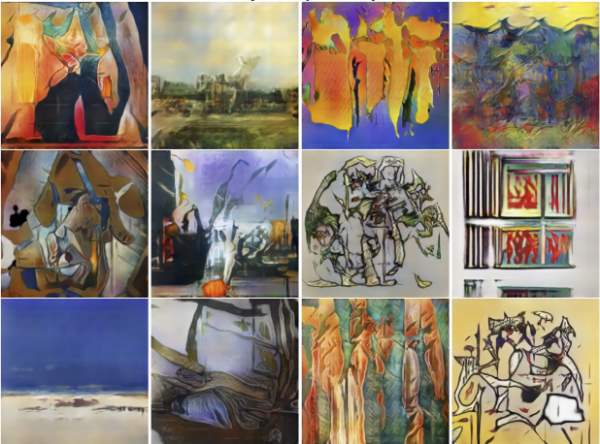
Professor Elgammal machine generated art
Needless to say not everyone reacted positively. Art critic and historian James Elkins remarked “this is annoying”, machine generated art is missing the point of art. Elkins comments that the algorithm was created by “people who think that styles are what matters in art”, and further quips that “it implies that a paintings style is sufficient to make it a masterpiece”. According to Elking the missing factor from A.I. generated art is the lack of thought- the “social contexts, meaning, and expressive purpose”. Michael Connor, an artistic director, also points out the gap between manmade and A.I made artwork. Connor remarked “making art…is about creating a body of work, teaching, activism, using social media, building a brand”. Connor further compares Elgammals’ computer generated art to that of a counterfeit and fraud, “it’s a weird copy of human culture”. Elgammal defended his creation, replying that his computer has learned to create, and it is in fact reflecting the natural progress over the centuries, in which art has become more abstract in nature.
Hughes (2005) wrote “Value rises from deep in the work itself – from its vitality, its intrinsic qualities, its address to the senses, intellect, and imagination; from the uses it makes of the concrete body of tradition”. One could argue that the A.I generated art stems from a ‘body of tradition’ is so far as the computer was fed traditional art from the 15-20th century. The art viewed by the public was well received, and was described as inspirational. Could one argue that the A.I. generated art could be valuable? While A.I. generated art lacks in certain areas, such as lack of concept, can it still be considered as important? Such a new concept to the art world must struggle along until we can define it, examine it, and judge its value. As with all newly introduced art mediums, we as artists must adjust to the concept. Indeed Reichle (2009) writes exclusively about artists pushing the boundaries between art and science. Many of the artists included could not have created their artwork without the use of computers. Interestingly Reichle comments “in the age-old desire for a Utopia in the here and now, a concept of a human being is articulated that is inspired by the idea of “optimization” and “enhancement” and seeks to replace nature with rational artificial entities”. Reichle points to mans quest to create A.I., and states that many are excited by the possibility of AI in the near future “many artists find it highly interesting that artificial life calls the boundary between the living and the non-living into question”. Perhaps A.I. that creates artwork is a step too far at present. In the future this artwork may be commonplace, in galleries alongside the master painters. A.I. has an uncertain future, but regardless of the outcome, it is an interesting topic at present.
Coeckellberg (2016) argues that the human hand is never entirely removed from the creative process. It is “always a hybrid human/non-human, human/technological process”. The algorithm could not create the artworks without first being created by a human. A human must program the A.I. and give specific instruction to create artwork. Countless lines of code need to be written, parameters set, and reset, and numerous readjusting followed by numerous tests before recognisable art is created. I feel the human hand may never truly be removed from the creation of art.
Conclusion
To conclude, I believe that technology has, and continues to, extends the possibility for contemporary artists and for their artwork. Artists have embraced technology, and with stunning artworks to show as a result. Technology has eased many aspects of the creative process for us, allowing greater freedom to make than ever before. While there are some drawbacks, these too I am sure will be resolved. Never has a single creation as the computer had such an impact on the art world. Every aspect of art can be influenced, should the artist choose so. That the artist has such control can only be viewed in a positive light. Currently artist are exploring and pushing the boundaries with the aid of technology. Looking into the future I feel that artwork will continue to benefit from technology, although A.I. generated artwork has a very uncertain future right now. Valery (1931, as cited by Benjamin 2010) reflected on the influence of machine on artwork, though the sentiment is very applicable today: “We must expect great innovations to transform the entire technique of the arts, thereby affecting artistic innovation itself and perhaps even bringing about an amazing change in our very notion of art”.
Reference List
Artsy.net. (2017). David Hockney. [online] Available at: https://www.artsy.net/artist/david-hockney [Accessed 29 Sep. 2017].
Benjamin, W. (2010). The work of art in the age of mechanical reproduction. Lexington, KY: Prism Key Press.
Botella, M., Glaveanu, V., Zenasni, F., Storme, M., Myszkowski, N., Wolff, M. and Lubart, T. (2013). How artists create: Creative process and multivariate factors. Learning and Individual Differences, [online] Volume 26,(August), pp.Pages 161-170. Available at: http://www.sciencedirect.com/science/article/pii/S1041608013000356?#! [Accessed 15 Nov. 2017].
Candy, L. and Edmonds, E. (2002). Explorations in art and technology. Berlin: Springer.
Carey, C. (2011). Cosmic Thing: Astrology, Space Science, and Personal Cartography in Robert Rauschenberg’s Autobiography. [online] Adsbit.harvard.edu. Available at: http://adsbit.harvard.edu/cgi-bin/nph-iarticle_query?bibcode=2011ASPC..441..221C&db_key=AST&page_ind=1&plate_select=NO&data_type=GIF&type=SCREEN_GIF&classic=YES [Accessed 1 Nov. 2017].
Chayka, K. (2015). The Greatest Digital Artists of the 21st Century. [online] Complex. Available at: http://www.complex.com/style/2015/05/the-greatest-digital-artists-of-the-21st-century/ [Accessed 28 Oct. 2017].
Chayka, K. (2012). [#DIGART] JODI Makes Art Online, But Don’t Call Them Net Artists. [online] Available at: https://creators.vice.com/en_uk/article/8qmy73/digart-jodi-makes-art-online-but-don%E2%80%99t-call-them-net-artists [Accessed 31 Sep. 2017].
Digital Divide Claire Bishop on Contemporary Art and New Media. (2017). [ebook] Artforum. Available at: http://www.corner-college.com/udb/cproob2RNIDigital_Divide.pdf [Accessed 14 Oct. 2017].
Gamboa, S. (2017). The Influence of Technology in Art Appreciation and Sales as a Factor in the Sustainability of the Retail Art Industry.[online] Usf.edu. Available at: http://www.usf.edu/business/documents/undergraduate/honors/thesis-gamboa-sarah.pdf [Accessed 1 Nov. 2017].
Hughes, R. (2005). The shock of the new Art and The Century of Change. 3rd ed. London: Thames and Hudson Ltd; Rev Ed edition.
Jones and Beagrie (2002). Digital Preservation Handbook. [online] Dpconline.org. Available at: http://www.dpconline.org/handbook/digital-preservation/preservation-issues [Accessed 1 Dec. 2017].
Le Maître, B, Hediger, V, Noordegraaf, J, & Saba, C. (2013) Preserving And Exhibiting Media Art : Challenges And Perspectives, Amsterdam: Amsterdam University Press, eBook Academic Collection Trial, EBSCOhost, [Accessed 1 December 2017].
Niland, L. (2012). David Hockney: The art of technology. The Guardian, [online] p.1. Available at: https://www.theguardian.com/theguardian/from-the-archive-blog/2012/jan/19/david-hockney-art-technology [Accessed 1 Nov. 2017].
Patentsoffice.ie. (2017). Copyright – PatentsOffice. [online] Available at: https://www.patentsoffice.ie/en/About-Us/Frequently-Asked-Questions/Copyright/ [Accessed 13 Nov. 2017].
Pritchard, H. and Prophet, J. (2015). Diffractive Art Practices: Computation and the Messy Entanglements between Mainstream Contemporary Art, and New Media Art. Artnodes, [online] (15), pp.5-14. Available at: http://artnodes.uoc.edu [Accessed 30 Sep. 2017].
Reichle, I. (2009). Art in the age of technoscience. Wien: Springer-Verlag.
Tate. (2017). David Hockney. [online] Available at: http://www.tate.org.uk/art/artists/david-hockney-1293 [Accessed 1 Nov. 2017].
The Guardian (1999). My worthless Hockneys. [online] p.1. Available at: https://www.theguardian.com/theguardian/1999/oct/14/features11.g22 [Accessed 3 Nov. 2017].
The Metropolitan Museum of Art, i.e. The Met Museum. (2017). David Hockney. [online] Available at: https://www.metmuseum.org/exhibitions/listings/2017/david-hockney [Accessed 29 Nov. 2017].
Weschler, L 2013, ‘David Hockney s Timescapes’, Virginia Quarterly Review, 89, 4, pp. 63-75, Academic Search Complete, EBSCOhost, viewed 24 October 2017.
Weschler, L. (2013). Why David Hockney Has a Love-Hate Relationship With Technology. [online] Smithsonian. Available at: https://www.smithsonianmag.com/arts-culture/why-david-hockney-has-a-love-hate-relationship-with-technology-864777/ [Accessed 17 Sep. 2017].
Woolf, A. (2016). The impact of technology. England: Rainleaf.
Cite This Work
To export a reference to this article please select a referencing stye below:
Related Services
View allRelated Content
All TagsContent relating to: "Technology"
Technology can be described as the use of scientific and advanced knowledge to meet the requirements of humans. Technology is continuously developing, and is used in almost all aspects of life.
Related Articles
DMCA / Removal Request
If you are the original writer of this dissertation and no longer wish to have your work published on the UKDiss.com website then please:




